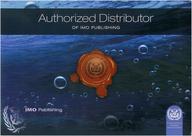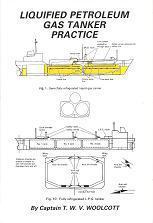Catálogo - LIBROS NÁUTICOS - Transporte marítimo, Fletamentos, Economía Marítima y Puertos
Liquified petroleum gas tanker practice
Autor: T. W. V. Woolcott
Editorial: Brown, Son & Ferguson
Año de edición: 1.987 (2ª edición, revisada en 2.009)
9780851748122
Encuadernación: cartoné
142 pág.
16,5 x 23,5 cm.
50,00€
Contenido:
The dramatic increase in the movement of liquified gases in recent years has called for new skills and technology in Marine Transport.
The purpose of this book is to indicate the nature of the problems that have to be faced in the transport of liquified gases, and the nature of the operations needed for their safe carriage.
In this book, the reader is introduced to the types of equipment used in gas carriers and their safe operation covering all circumstances.
In view of the nature of the cargo, the keynote is safety: safety of the ship, safety of the cargo, safety of the crew and protection of the environment.
Índice:
Introduction
PART I. PRESSURE SHIPS
CHAPTER I. GENERAL DESCRIPTION
CHAPTER II. GENERAL OPERATING PRINCIPLES
Loading
Discharging
Refrigerating the cargo
Gas-freeing
CHAPTER III. CARGO HANDLING EQUIPMENT
Cargo pumps
Cargo compressors
Condensers
Heat exchangers
Vaporiser
Cargo heater
CHAPTER IV. CONDUCT OF CARGO OPERATIONS
Semi-refrigerated cargoes
Loading
Discharging
Refrigerating the cargo
Gas-freeing
Fully-refrigerated cargoes at atmospheric pressure
Loading
Discharging
Two-stage refrigeration
Precautions to be taken when starting a compressor
Points to watch whilst a compressor is running
PART II. FULLY-REFRIGERATED SHIPS
CHAPTER V. GENERAL DESCRIPTION
CHAPTER VI. GENERAL OPERATING PRINCIPLES
Loading
Refrigerating the cargo on passage
Two-stage reliquifaction
Discharging
Gas-freeing
To gas-up the tanks after the have been gas freed
To cool down the tanks prior to loading
Summary of gas-freeing and gassing-up
CHAPTER VII. CARGO HANDLING EQUIPMENT
Two-stage refrigeration
Two-stage compressors
Seawater-cooled condensers
The inter-stage cooler
The heat exchanger
Cascade system of refrigeration
R.22 Compressors
R.22 Condensers
R.22 Receivers
The cargo compressors
The cargo condensers
Methanol injection system
Vaporisers
Air dryer
Cargo dryer
Cargo heaters
Submerged cargo pumps
Emergency cargo pumps
Deck storage tanks
CHAPTER VIII. CARGO OPERATING PROCEDURE
Loading
To refrigerate the cargo on passage
Two-stage reliquifaction
Points to watch whilst the plant is running
Cascade system of reliquifaction
Thermostatic control valves
Refrigeration gauges
Starting the compressors
Points to watch whilst the plant is running
To shut down the system
Other points to watch
Discharging
To gas-free the vessel
Puddle heating
To estimate the time it will take to puddle heat
Tank warming
Inerting the cargo tanks
Flushing through with air
Partial gas-frees
Preparing the tanks to receive cargo after they have been gas-freed
Drying the air in the cargo tanks
To operate the air dryer
To inert the tanks prior to gassing-up
To gas-up the cargo tanks (at sea)
To gas-up the tanks alongside
Cooling down the cargo tanks
Procedure when changing grades and types of cargo
Trouble shooting guide
PART III. GENERAL
CHAPTER IX. CARGO CALCULATIONS
To calculate the quantity of liquid on board (metric)
To calculate the weight of vapour on board (imperial and metric)
Assessing the volume of vapour
To calculate the quantity of liquid on board (imperial)
To calculate the correct volume of liquid to load when loading a full cargo.
Expansion relief valves in liquid lines
To calculate the correct volume of liquid to load when loading a part cargo
To calculate the S.V.P. of a mixture of products at a given temperature
To calculate the individual prportions of vapour in the vapour mixture above a liquid mixture
Molecular weights
Aid to memorising the formulae
Comparison of metric and imperial systems
Heat gains in transfer
Table of properties
CHAPTER X. SAFETY
Safe navigation
Safe practice
Safety inspections
Gas detection
Fire detection
Fire-fighting
Refits and repairs
Precautions to be taken when entering spaces which may have a deficiency of oxygen
CHAPTER XI. RECOMMENDATIONS
Safe navigation
Harbour control
Protection of gas-tankers moored alongside
Emergency isolation valves for safety valves
Greater consultation between operators and design staff.
Fitting of ring main fracture lines.
Glossary of terms used
Precio: 50,00 €, I.V.A. incluido (4%)
[ Volver ]


